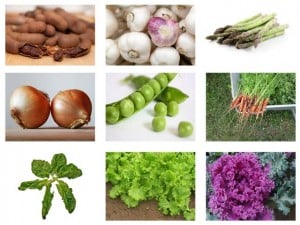
By: Amanda Froelich,
Frigid weather and inclination to stay inside don’t mean one needs to miss the refreshing crisp air or the health benefits plant foods have to offer. In fact, the following ten foods are easily grown over winter; they’ll not only flourish in the low double digits but can be a hearty addition to any warm dinner.
A garden grown during the winter can supplement your food supply, give one an excuse to be outside, and can be a great way to reconnect with nature while most life hibernates.
1. Broad Beans
Autumn-sewn broad beans stop nutrients from leaching through otherwise fallow soil, which allow its structure to deteriorate. Steamed with coconut oil, they are an easy-to-produce garden food which may make the winter months more bearable.
2. Asparagus
Many varieties of Asparagus are now ready for autumn planting, helping to establish them much quicker. If you keep the bed weed-free they can take much less work than other annual vegetables. This gourmet extravaganza may take 2 years to mature, but they’re delicious, abundant in Fiber, Vitamins A, C, E, and K, and are rich in anti-oxidants.
3. Pea and Pea Shoots
This crop will yield late spring but is worth sowing in the cold season. Tasty, rich in Vitamin A and K, and satisfying, peas and pea shoots can be grown in groups, allowing for a bountiful harvest when spring arrives.
4. Garlic
One of the easiest crops to grow, cloves can be planted towards the end of the year and hoed in February/March. Rich in sulfur and anti-bacterial and anti-parasitic qualities, the addition of roasted garlic in the holiday season is priceless. Grow your own and reap the benefits.
5. Onions, Spring Onions, and Shallots
If planted at the present time, onions can be harvested at the beginning of the year. Similar to garlic in health benefits, many varieties can be planted and are a nice addition to any meal.
6. Winter Lettuce
Greens are known to be one of the healthiest foods for humans, boost your immune system and save money on the heart-healthy nutrients they provide. Growing varieties such as Niche Mixed or Meraviglia d’Inverno San Martino will yield tasty food and many vitamins and minerals.
7. Lamb’s Lettuce
A great filler high in anti-oxidants, Vitamin A, K, C, and E, and undemanding to grow, Lamb’s lettuce is a green that should be in everyone’s winter garden. It does not need high light levels and tolerates low temperatures so can be sown around the end of October. Picked until December or into the New Year, it can bulk up salads and enrich one’s health.
8. Spinach
Another green that is highly popular, spinach shares similar health benefits to Winter Lettuce and Lamb’s Lettuce. Varieties that will tolerate late planting and cold winters include: Riccio d’Asti and Merlo Nero (seeds of Italy). In smoothies, salads, or wilted with steamed vegetables, spinach is delicious and abundant in valuable nutrients.
9. Sugarsnap Peas
If one chooses a variety such as Snow Pea Gigante Svizzero (seeds of Italy), they can be planted over winter to produce a crop of smallish, edible pods next year.
10. Carrots
For an early year crop, sew carrots around November. Rich in Vitamin A, fiber, and anti-oxidants, carrots need little to no shelter and are full of life-promoting benefits.
11. Kale
This hearty green vegetable is not only a super food because of its abundant nutrient-mineral profile, but also braves the freezing climate. Full of Magnesium, B vitamins, Vitamin A, K, and Folic Acid, Kale is a green that is easy to cultivate in certain northern areas where temperatures frequently drop.
If you’re seeking to improve your health, save money on your food bill, and have a drive to become more connected with nature, consider growing a garden with these cold-hardy plants during the most wonderful time of the year.
Sources:


